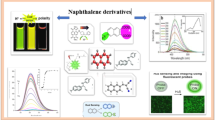Abstract
The use of fluorescent reagents for the histochemical detection of catecholamines or histamine, as well as luminescent antagonists of the intracellular neurotransmitters revealed that they can bind to certain cellular compartments. After the treatment with glyoxylic acid (a reagent used for the detection of catecholamines), blue fluorescence with maximum at 460–475 nm was visualized in nuclei and chloroplasts (in control preparations no emission in this spectral region was recorded), as well as an intense fluorescence, exceeding the control level, in the vacuoles. After the exposure to ortho-phthalic aldehyde (a reagent used for the histamine detection), blue emission was more noticeable in nuclei and chloroplasts, which correlates with previously observed effects on intact cells, such as pollen and vegetative microspores. A comparison of the intensities of the biogenic amine-related emission in various organelles showed that the greatest emission was in vacuoles and the weakest, in chloroplasts. Thus, on the surface, and possibly within the organelles, fluorescence could demonstrate the presence of biogenic amines. Antagonists of the neurotransmitters (dtubocurarine for acetylcholine; yohimbine for dopamine; norepinephrine and inmecarb for serotonin), which fluoresce in the blue and blue-green region and usually bind with the plasmalemma of intact cells, also interacted with the membranes of the organelles studied. Fluorescence intensity depended on the object; most prominent it was for yohimbine in the outer membrane of the nucleus, vacuoles, and chloroplasts.
Similar content being viewed by others
References
Roshchina V.V. 2010. Evolutionary considerations of neurotransmitters in microbial, plant and animal cells. In: Microbial endocrinology. Interkingdom signaling in infectious disease and health. Eds. Lyte M., Freestone P.P.E. New York, Berlin: Springer-Verlag, p. 17–52.
Roshchina V.V. 2001. Neurotransmitters in plant life. Enfield, Plymouth: Science Publ.
Kimura M. 1968. Fluorescence histochemical study on serotonin and catecholamine in some plants. Jap. J. Pharmacol. 18, 162–168.
Barwell C.J. 1989. Distribution of histamine in the thallus Furcellaria lumbricalis. J. Applied Phycol. 1, 341–344.
Roshchina V.V., Bezuglov V.V., Markova L.N., Sakharova N.Yu., Buznikov G.A., Karnaukhov V.N., Chailakhian L.M. 2003. Interaction of living cells with fluorescent derivatives of biogenic amines. Dokl. RAN (Rus.). 393 (6), 832–835.
Roshchina V.V. 2004. Cellular models to study the allelopathic mechanisms. Allelopathy J. 13 (1), 13–16.
Roshchina V.V. 2008. Fluorescing world of plant secreting cells. Enfield, Plymouth: Science Publ.
Roshchina V.V., Yashin V.A., Vikhlyantsev I.M. 2012. Fluorescence of plant microspores as biosensors. Biol. Membrany (Rus.). 28 (6), 547–556 [Translated version in: Biochem. (Moscow) Suppl. Series A: Membr. Cell Biol. 6 (1), 105–112].
Roshchina V.V. 2014. Model systems to study excretory function of higher plants. Dordrecht, Heidelberg: Springer.
Roshchina V.V., Yashin V.A., Kuchin A.V., Kulakov V.I. 2014. Fluorescent analysis of catecholamines and histamine in plant single cells. Int. J. Biochem. Photon. 195, 344–351.
Roshchina V.V., Yashin V.A. 2014. Neurotransmitters catecholamines and histamine in allelopathy: Plant cells as models in fluorescence microscopy. Allelopathy J. 34 (1), 1–16.
Arkhipova L.V., Tretyak T.M., Ozolin O.N. 1988. The influence of catecholamines and serotonin on RNAsynthesizing capacity of isolated nuclei and chromatin of brain and rat liver. Biokhimia (Rus.). 53, 1078–1081.
Roshchina V.V. 1990. Biomediators in chloroplasts of higher plants. 3. Effect of dopamine on photochemical activity. Photosynthetica. 24 (1), 117–121.
Roshchina V.V. 1990. Biomediators in chloroplasts of higher plants. 4. Reception by photosynthetic membranes. Photosynthetica. 24 (4), 539–549.
Roshchina V.V. 2006. Chemosignaling in cells of plant microspores. Izvestia RAN. Ser. Biologia (Rus.). 33 (4), 414–420.
Salyaev R.K., Kuzevanov V.Ya., Khaptagaev S.B., Kopytchuk V.N. 1981. Isolation and purification of vacuoles and vacuolar membranes from plant cells. Fiziologia rastenii (Rus.). 28 (6), 1295–1305.
Robinson S.P., Edvards G.E., Walker D.A. 1979). Established methods for the isolation of intact chloroplasts. In: Plant organelles. Ed. Reid E. Chichester: Ellis Horwood, p. 13–24.
Markova L.N., Buznikov G.A., Kovacevic N., Rakic L., Salimova N.B., Volina E.V. 1985. Histochemical study of biogenic monoamines in early (“Prenervous”) and late embryos of sea urchins. Int. J. Develop. Neurosci. 3 (5), 493–499.
Kutchan T.M., Rush M., Coscia C.J. 1986. Subcellular localization of alkaloids and dopamine in different vacuolar compartment of Papaver bracteatum. Plant Physiol. 81 (1), 161–166.
Andreev I.M. 2012. Role of vacuole in redox-homeostasis of plant cells. Fiziologia rastenii (Rus.). 59 (5), 660–667.
Roshchina V.V., Markova L.N., Bezuglov V.V., Buznikov G.A., Shmukler Yu.B., Yashin V.A., Sakharova N.Yu. 2005. Linkage of fluorescent derivatives of neurotransmitters with plant generative cells and animal embryos. In: Reception and Intracellular Signaling. Ed. Zinchenko V.P. Proceedings of the International Conference, 6–8 June 2005, Pushchino, Biological Center of Russian Academy of Sciences, Pushchino, p. 399–402.
Author information
Authors and Affiliations
Corresponding author
Additional information
Original Russian Text © V.V. Roshchina, V.A. Yashin, A.V. Kuchin, 2016, published in Biologicheskie Membrany, 2016, Vol. 33, No. 2, pp. 105–112.
Rights and permissions
About this article
Cite this article
Roshchina, V.V., Yashin, V.A. & Kuchin, A.V. Fluorescence of neurotransmitters and their reception in plant cell. Biochem. Moscow Suppl. Ser. A 10, 233–239 (2016). https://doi.org/10.1134/S1990747816010098
Received:
Accepted:
Published:
Issue Date:
DOI: https://doi.org/10.1134/S1990747816010098




